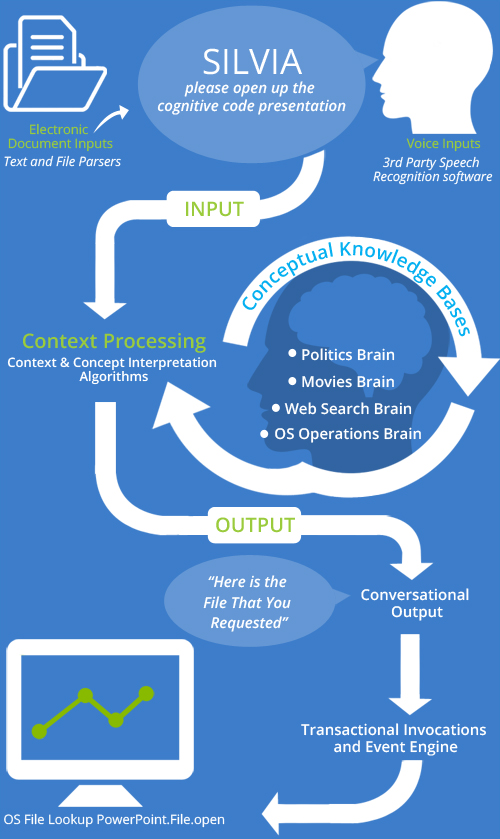SILVIA is short for Symbolically Isolated Linguistically Variable Intelligence Algorithms.
SILVIA is actually an acronym that stands for “symbolically isolated, linguistically variable, intelligence algorithm.” That’s quite a mouthful for sure, so let’s break it down. “Symbolically isolated,” refers to the unique method SILIVA uses to process language input. SILVIA doesn’t work in the same way as chatbots built with AIML (Conversational Intelligence Mark-Up Language). The AIML runtime platform takes words as input, matches these words to patterns in the chatbot’s database, and issues predefined phrases as output. SILVIA takes words for input, but she transforms them into a mathematical language all her own. As speech or text enters her brain, her runtime system isolates those words into an intelligence core based on symbols and statistical relationships.
“Linguistically variable” refers to the fact that SILVIA isn’t tied to any one language. Because the SILVIA brain thinks in terms of mathematical units, SILVIA is a polyglot who can easily switch from one language to another without requiring special programming.
The “intelligence algorithm” part of SILVIA’s name refers back to the statistical runtime of the platform. Because SILVIA doesn’t rely solely on simplistic pattern matching, she is able to conceptualize meaning from input and dynamically generate new output. With the ability to connect concepts and ideas, SILVIA can engage in something akin to a real conversation. She’s also easier to “train” than a normal chatbot, because you’re not required to pre-populate her database with every possible question and answer. You also don’t have to account for misspellings or different ways of asking the same question. SILVIA’s flexible intelligence core can sort those things out automatically.
So what sets SILVIA apart from other conversational intelligence systems, speech recognition or any other technology? SILVIA’s patented technology is NOT necessarily server-based. Yes you read that right. SILVIA can run natively on devices. SILVIA can operate within the context of a client’s desktop application, mobile device, as part of our SILVIA Server, or as a node in a peer-to-peer network, and of course in the cloud.
The SILVIA platform consists of the runtime, a developer studio, extensible plug-ins to connect to data sources or applications, and brain files that control the app’s behavior. The built-in database makes it possible for SILVIA to learn and remember the preferences of those she serves. She can use this stored knowledge in a number of ways, including to infer user intent and to proactively engage the user.
SILVIA is NOT a speech recognition technology, rather she connects with 3rd party speech recognition solutions (like Nuance, Google Voice, and others) and takes human language input, converts it into a mathematical algorithm, and decides what needs to be executed, while formulating a response to the user.
Components of the SILVIA Technology
SILVIA Core: A high-performance runtime engine, configurable for client, server, or mobile / embedded
SILVIA Server: A configurable system for automated management of n SILVIA Cores on one or more networked servers
SILVIA Voice: A modular add-on component for accepting voice input and rendering voice output within a client application, a web page, or as part of SILVIA Server for optimized streaming media
SILVIA API: Allows programmers to create new applications and plug-in based functionality
SILVIA Studio: A graphical system for application-specific behavior development
SILVIA Integrated Technology- Intelligence On Command
The diagram below is a relatively simplistic decomposition of SILVIA’s conversational intelligence system, and illustrates how the sub-systems are combined and integrated into the SILVIA system as a whole.

SILVIA Architectural Flow – The Blueprint That Allows For Conversations
Click Here to view the blueprint that shows both the development and the flow of the interactions that allows for the creation of conversational applications that listen and talk by providing a detailed technical input deconstruction and output construction into the design and architecture approach.
